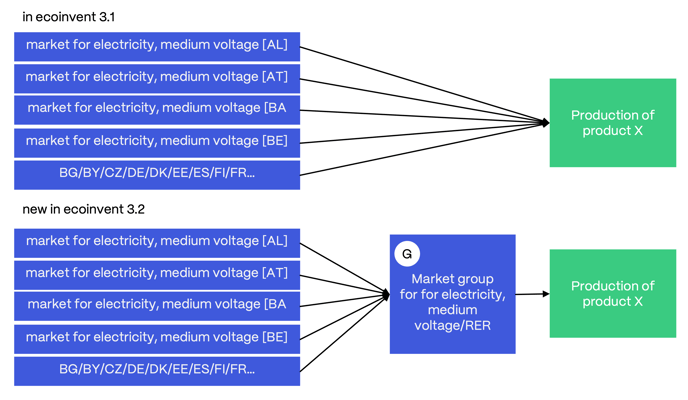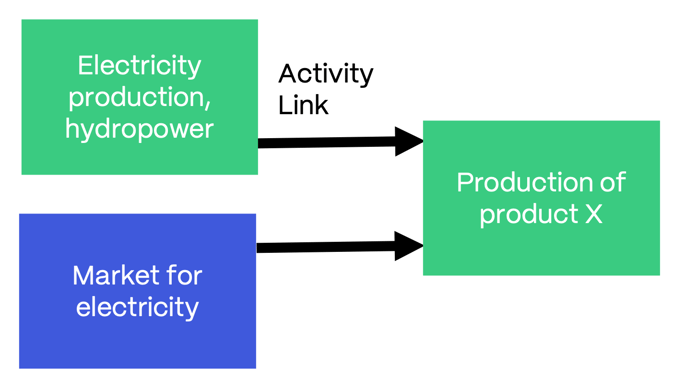Market Activities
A market activity represents the consumption mix of a product for a given region, accounting for the trade between the producer and consumer, and, when needed, for product losses that occur during the product’s transportation.
Oct 24th, 2023
A market dataset does not transform a product but rather simply transfers it from one transforming activity to another.
In the attributional system models (i.e., the cut off system model and the APOS system model), markets represent the average consumption mix of the selected product in the relevant region(s). In the consequential system model, a market represents the marginal consumption mix; it is therefore supplied by unconstrained activities with an up-to-date technology level.
Market activities for waste (materials for treatment) are defined as treatment mixes rather than consumption mixes. The market is composed of the different activities that provide a treatment (e.g., landfill, incineration) for the selected product.
Regional Definition and Market Groups

A visual representation of an import activity.
Market datasets may refer to a global or local situation. Products that are traded only globally are represented by a global (GLO) market, while products that are traded locally are available in one or more local markets and often in an additional Rest-of-the-World (RoW) market.
For example, bananas are traded globally, while heavier materials, such as concrete, are often consumed in the producing region. Eventual trade with neighbouring countries is modeled with import activities.
Imports and Exports
Import and exports are modeled, where needed, to better represent the regional reality. In the ecoinvent database, trade between regions is always represented by an import activity.
Hard coal is an example of such a product. Europe receives a substantial portion of its hard coal supply from Australia. An import dataset transfers hard coal from the Australian market activity for hard coal to the European market activity for hard coal. The import activity contains data on the amounts of hard coal transferred annually from Australia to Europe, the average distances and modes of transport required and the product losses occurring during transport, loading and unloading. The European market activity for hard coal is thus supplied by all activities producing hard coal in Europe and by all imports from other markets to Europe. Import activities carry the name “… import from X.” For example, the activity “hard coal, import from Australia” in geography Europe models the transfer of coal from Australia to Europe.
Market Groups
A market group is a market dataset exclusively created by market activities that are concerned with the same product but cover different regions. Therefore, the geography of the market group contains the geography of all supplying markets. For example, the “market group for electricity, medium voltage” in Europe (RER) bundles markets for medium voltage electricity in more than thirty countries, including Poland (PL) and Austria (AT).
This feature was introduced in version 3.2 to facilitate readability. Previously, users would see all the individual European markets supplying electricity to the consumer; now, users see only the “market group for electricity, medium voltage”/RER.

A visual representation of a market group.
Market Composition
After taking into consideration regions and system model rules, market composition is determined based on production volumes. The shares can be obtained by accessing the linked unit process in ecoQuery. Additionally, the spreadsheet “market_composition_X.X.xlxs” summarizing market shares and production volumes for all system models is available in the files section of ecoQuery.
In certain instances, such as electricity, market mixes are generated by directly editing the contribution of the producing activities to the markets in the market activity itself (feature introduced in version 3.4).
Relevant links on Electricity:
- How are electricity market mixes modeled? (FAQ)
- How can I see the technology mix of an electricity market? (FAQ)
Relevant links on municipal solid waste markets:
Transport and Product Losses
Market activities account for the average transport distances and modalities of the product from producer to consumer. Transport information is set by the data provider; when information is not available, default transport assumptions are used. The global and Swiss default transport assumptions can be downloaded in the report section of ecoQuery.
Transport in the market is expressed in tonne-kilometres (ton*km) per unit of the reference product. For all products, the wet mass property is used to calculate the transport values.
Market datasets also account for losses occurring between producers and consumers, when relevant. Losses are modeled with an input of the product itself to the market, in addition to the amount of product delivered to the consumer. For example, the consumption of 1 kg of the product “strawberry” in the “market for strawberry” requires the input of 1.1 kg of the product to the market because 0.1 kg of strawberries are lost, i.e., become biowaste during transportation.
Direct Links
In the ecoinvent database, markets are the default suppliers for activities in the same geographical area, but this can be specified differently, using direct links between the producing and consuming activities of a product.
A direct link is set when the supplier is known. In this case, the market dataset is not needed as a bridge between these producing and consuming activities. Eventual transportation and losses are added directly in the consuming (transforming) activity in those cases. Direct links are used for services or products that are not traded (i.e., immobile infrastructure, intermediate products).
Example
Energy-intensive industries often own power plants to supply at least part of their own electricity consumption. In these cases, the industry knows how much of the electricity it consumes is supplied by its own plant and by which technology (e.g., hydropower).

A visual representation direct activity link, i.e. a direct link between the producing and consuming activities of a product.
Editors
Emilia Moreno Ruiz (Main Editor), ecoinvent Association, Switzerland